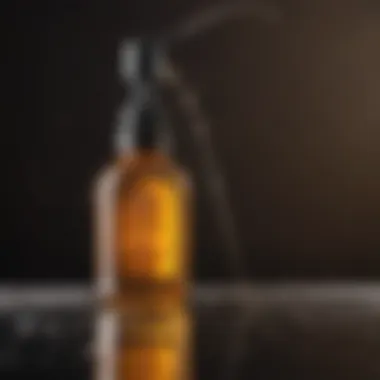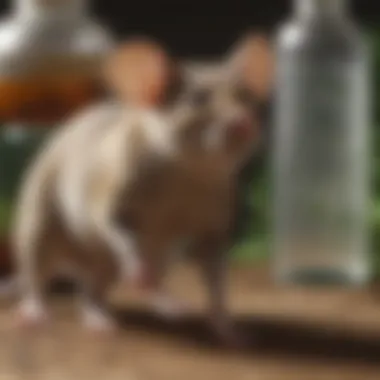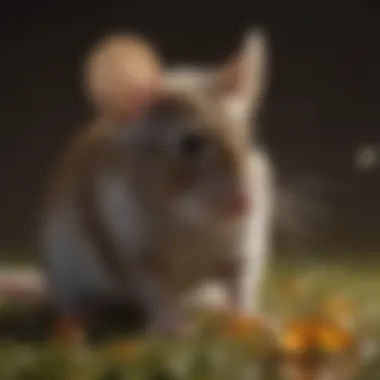Understanding Liquid Mouse Repellents: A Guide


Intro
When dealing with pesky mice in our environments, particularly in the realms of agriculture and horticulture, it’s essential to understand the tools at our disposal. One such tool that has gained traction in pest management is liquid mouse repellent. This guide delves into the components, effectiveness, and techniques surrounding these repellents while maintaining a keen eye on their environmental ramifications.
Liquid mouse repellents are not merely a trend. They play a significant role in integrated pest management strategies. However, as any farmer or gardening enthusiast knows, navigating the diverse options available can be as complicated as the twisting roots of a gnarled tree.
To begin, it’s crucial to grasp a few basic concepts and terminology linked to liquid mouse repellents before we venture deeper into their workings and applications.
Prelude to Liquid Mouse Repellents
Liquid mouse repellents have become a crucial element in the arsenal of pest control methods available to both agricultural professionals and horticulture enthusiasts. Understanding these repellents isn't just a matter of preference but a necessity for effective pest management. As farms and gardens face rising challenges from mouse populations, the importance of these repellents becomes evident. Not only do they aid in protecting crops, but they also minimize the risk of disease and damage associated with rodent infestations.
Overview of Pest Control Methods
Pest control has evolved significantly over the years. While traditional methods like traps and poisons are still in use, they often come with limitations. Liquid mouse repellents present a different approach. They can be an integral part of Integrated Pest Management (IPM) strategies. Here’s a brief overview of common pest control methods:
- Chemical Methods: Use of pesticides and rodenticides to eliminate mice. While effective, they often pose risks to non-target species, including pets and beneficial insects.
- Mechanical Methods: Traps remain a popular choice, but their effectiveness heavily relies on placement and regular monitoring.
- Cultural Practices: This involves managing the environment to deter pests, like sealing entry points and maintaining sanitary conditions.
- Biological Control: Introducing predators or parasites of the pests, although this method can be complex and is not always feasible.
Liquid repellents fit into this spectrum by creating a barrier that mice find unwelcoming while being less harmful to the environment. They serve as a preventative measure instead of a reactive one, providing a proactive solution that catch the eye of many looking to safeguard their spaces.
The Role of Liquid Repellents
The role of liquid repellents is multifaceted. Unlike poisons which aim to kill, repellents primarily work to deter pests from inhabiting an area. They rely on the principle that certain smells or toxins can irritate the senses of mice, steering them away from treated zones.
Here are some specific roles liquid repellents play:
- Prevention of Infestation: Regular application of these products can help keep mice at bay, reducing the likelihood of severe infestations later on.
- Plant Protection: For those involved in agriculture, applying repellents can safeguard crops. Mice often nibble on young plants, causing irreparable harm.
- Improved Crop Yield: By minimizing pest interference, farmers can potentially see an increase in yield, as crops can grow without the stress of being eaten.
The efficacy of liquid repellents can depend significantly on factors such as the formula, application technique, and even environmental conditions. Each piece of the puzzle plays a role in determining how well these repellents can function. Given all the insights shared, the further sections will delve deeper into the specific components and mechanisms that make liquid mouse repellents essential tools in pest management.
Composition of Liquid Mouse Repellents
When it comes to liquid mouse repellents, understanding their composition is crucial. The effectiveness of these repellents largely hinges on the combination of ingredients used. Each ingredient plays a significant role in thwarting rodent behavior, helping farmers and pest management professionals tackle the pest problem effectively. By dissecting the components, users gain insights into what truly makes a repellent effective, which can guide decisions on which products to choose.
Active Ingredients
Active ingredients in liquid mouse repellents are the heavy hitters, the elements primarily responsible for deterring mice. This includes substances that produce strong odors or may have irritating effects on the rodents. For instance, natural oils such as peppermint oil or eucalyptus oil are commonly employed for their scent, which many believe is unappealing to mice.
Some chemical compounds, like Nootkatone, while not as widely known, have been making waves in pest control due to their effectiveness in altering mouse behavior. These active compounds send a clear message to the pests: this area is not hospitable.
The potency of these ingredients also varies. For example, some formulations might combine various oils to enhance the overall efficacy. The balance and concentration of these components can significantly affect how quickly and effectively a product works. Therefore, when choosing a repellent, it's helpful to check the active ingredients and their concentrations, as those can be indicators of performance.
Inert Ingredients and Their Functions
While the active ingredients grab the limelight, inert ingredients quietly play their own vital roles. These aren’t merely fillers; they support the active ingredients' effectiveness and contribute to the product's stability and consistency. Quite often, these may include emulsifiers, solvents, or preservatives to ensure that the product retains its efficacy over time.
For example, water is a common inert ingredient used to dilute concentrated active substances, making it easier to apply while ensuring the repellent can be distributed evenly over a surface. Furthermore, some inert ingredients provide a sticky base, which helps the active ingredients adhere better to surfaces, allowing them to last longer and be more effective.
"Understanding both active and inert ingredients is essential for making informed choices in pest management."
Using inert ingredients wisely can lead to formulations that are more environmentally friendly and safe for non-target species as well. In summary, the composition of liquid mouse repellents, which includes both active and inert ingredients, must be carefully considered by anyone looking to effectively manage rodent populations.
How Liquid Mouse Repellents Work
Understanding how liquid mouse repellents work is essential for anyone dealing with these pesky intruders. These repellents don’t just keep mice at bay; they also offer insights into pest behavior and areas where traditional methods may falter. The study of how these products function helps in optimizing their use for effective rodent management. Grasping the underlying mechanics of these repellents can significantly impact the overall success of pest control efforts in various settings, be it agricultural fields or home gardens.
Behavioral Responses to Repellents
Mice are creatures of habit. They have established routes that they frequently travel in search of food or shelter. When introduced to liquid repellents, their natural tendencies may alter. Research indicates that effective repellents contain certain compounds that provoke a strong aversion in mice. It’s often noted that rodents have an acute sense of smell, and they rely heavily on this to navigate their environment.


For instance, the scent of peppermint oil in some formulations can send mice scurrying in the opposite direction. Studies have shown that when exposed to this smell, their instinct is to retreat rather than investigate. Success with repellents largely hinges on disrupting these habits.
"Disrupting rodent habits is the key to effective pest management."
In practical terms, when applying a liquid repellent, ensuring that the scent remains potent and widespread in the target area is crucial. Regular reapplication may be necessary, especially in areas with high foot traffic or where the weather conditions can easily wash away the repellent.
Effectiveness in Different Conditions
Liquid mouse repellents may not be one-size-fits-all solutions and their effectiveness can vary based on several environmental factors. Temperature, humidity, and even the presence of competing odors can influence how well these repellents work. For example, during wet seasons, a repellent applied outdoors may lose its strength quicker compared to dryer conditions, making it essential to monitor and maintain their effectiveness.
Another consideration is the substrate onto which the repellent is applied. Some surfaces absorb liquids more readily than others, which can affect retention and efficacy. A wooden surface might hold the scent longer than concrete, which is more porous. Thus, it’s wise to consider the nature of the area you're dealing with before choosing your application method.
In agricultural settings, incorporating repellents into integrated pest management strategies can pay dividends. Farmers who use these repellents in conjunction with trapping or exclusion methods may find that they are better able to reduce rodent populations effectively.
In summary, understanding behavioral responses and environmental factors is critical when utilizing liquid mouse repellents. By recognizing how these products work and the conditions under which they are applied, users can enhance the overall impact of their pest control strategies.
Application Techniques for Liquid Mouse Repellents
Effectively using liquid mouse repellents requires more than just spraying them around. The methods employed play a crucial role in determining how well these repellents work. A well-executed application ensures that the repellent reaches areas that mice frequent, maximizing its effectiveness while minimizing waste and potential harm to the environment.
Proper Dosage and Frequency
Getting the dosage right is pivotal. Whether you are a backyard gardener or managing fields, understanding how much repellent to use can make all the difference. Overdoing it can lead to resistance, and it could additionally be counterproductive.
- Understanding the Label: Always listen to the instructions on the product label carefully. They provide specific guidelines tailored for each repellent.
- Dilution Rates: Different products have varying concentrations. Some might be ready-to-use, while others may require dilution. Knowing which product you're using can help you avoid making a diluted mess.
- Frequency of Application: The climatic conditions and severity of the infestation are key factors determining how often you should apply the repellent. More frequent applications might be necessary during peak seasons when mice are most active.
Best Practices for Application
Applying liquid mouse repellents can be straightforward, but there are best practices that can enhance their effectiveness.
- Identify Key Locations: Target areas where you typically observe mouse activity, such as near entry points, nest sites, or food sources.
- Use Appropriate Equipment: Employ a sprayer that allows you to control the flow and direction of the repellent. A fine mist can cover a larger area and ensure even distribution.
- Timing Matters: Try to apply the repellent during times when mice are most active. Early morning or evening often sees more mouse movement.
- Environmental Conditions: Avoid applying in windy conditions or heavy rain, which could wash away the repellent or disperse it ineffective.
- Personal Protection: Ensure you wear gloves and a mask as some repellents may have strong odors or chemicals that could cause irritation.
“Proper application isn't just a science; it's an art.”
Adhering to these recommended application techniques culminates in more effective pest management. The combination of appropriate dosage and strategic application methods meld offers a powerful defense against unwelcome rodent visitors, enabling a more harmonious balance within your agricultural or gardening endeavors.
Environmental Considerations
Understanding the environmental considerations related to liquid mouse repellents is crucial for both efficacy and ecological integrity. As pest management strategies become more sophisticated, the methods of repelling mice also need to be evaluated with a critical eye. The choice of repellents will not only reflect their effectiveness against target pests but also their impact on the surrounding ecosystem.
Impact on Non-Target Species
When applying liquid mouse repellents, one has to consider the potential consequences on non-target species, such as beneficial insects, birds, and mammals. For instance, using a repellent laden with harsh chemicals might deter mice effectively but could also harm pollinators that come into contact with the treated areas. This unintended consequence could ripple through the local food chain. A few noteworthy points include:
- Selective Repellency: Some liquid repellents are designed to target specific rodents while minimizing harm to other wildlife. Understanding the active ingredients can lead to better choices that are less harmful.
- Behavioral Changes: Exposure to certain repellents can alter the behavior of non-target species, potentially leading them away from critical food sources or nesting sites.
- Environmental Compatibility: Utilizing compounds derived from plant-based materials often results in lower impact on non-target species. Natural repellents, for instance, can offer an eco-friendlier alternative without compromising too much on efficiency.
The effects on non-target species underscore the importance of selecting and applying repellents judiciously, ensuring that the ecological balance is maintained while addressing rodent issues.
Sustainability of Ingredients
In this age of heightened environmental awareness, the sustainability of the ingredients within liquid mouse repellents has gained significant traction. The sourcing and production processes of these products can meet the values of environmentally-conscious consumers. Key aspects to consider include:
- Biodegradability: Repellents that break down naturally in the environment reduce the long-term toxic load on ecosystems. Products with biodegradable formulations lessen pollution risks in soil and water systems.
- Sourcing Practices: Ingredients that are sustainably harvested, such as certain essential oils, not only contribute to effective pest repellence but also to ethical farming practices. Consumers can often find ingredient source claims on product labels, emphasizing transparency in the marketplace.
- Lifecycle Assessment: Ascertaining the environmental impact of the entire lifecycle of a product helps consumers make informed choices. This includes from raw material extraction to production, usage, and disposal. Repellents emphasizing minimal environmental harm throughout their lifecycle can offer peace of mind to users.
Through these sustainable practices, liquid mouse repellents can help pave the way towards integrated pest management methods that are both effective and aligned with environmental stewardship.
Using environmentally friendly products is not just about solving immediate pest problems; it's also about preserving the delicate ecosystems we rely on for food and health.
Regulatory Aspects of Liquid Mouse Repellents
The regulation surrounding liquid mouse repellents is not just a bureaucratic loop to jump through; it’s a vital aspect that safeguards both the users and the environment. Understanding regulation in this context provides a clearer lens through which agricultural professionals and horticulture enthusiasts can discern the quality and safety of the products they choose. From ensuring efficacy to protecting non-target organisms, robust regulatory frameworks help ensure that these repellents are both effective and responsible in their use.


Product Registration and Safety Standards
In the world of pest control, the importance of product registration can't be overstated. When a company develops a liquid mouse repellent, it must submit detailed information about its formulation, safety, and effectiveness to relevant authorities—usually mandated by government agencies like the Environmental Protection Agency (EPA) in the United States. This step isn't merely a formality; it's a thorough process designed to ensure that any substance released into the market does not pose a risk to humans, animals, or the environment.
- The approval process generally involves:
- Submission of safety data sheets.
- Evidence of efficacy through clinical or field trials.
- Assessment of potential impact on non-target species.
Obtaining registration not only legitimizes a product but also builds consumer trust. Farmers and hobbyists looking for solutions often feel more at ease choosing products backed by science and regulatory scrutiny. If a product meets safety standards set forth by respective agencies, it signifies a level of reliability that consumers can count on.
Labeling and Consumer Information
Labeling, often overlooked, serves as a crucial guide for users of liquid mouse repellents. It’s the key to a successful application and can dictate whether the repellent is effective or becomes a mere liquid in a bottle. Proper labeling conveys necessary information such as:
- Usage Directions: Understanding how and where to apply the repellent is crucial. A clear label ensures users don't apply too much or too little.
- Active Ingredients: Consumers can check for any components they may want to avoid, like known allergens or harmful substances.
- Safety Precautions: It is vital for users to know how to handle the product safely. Instructions regarding personal protective equipment (PPE) help mitigate any risk associated with misuse.
"An informed consumer is the best consumer. Good labeling helps create knowledgeable users who can make safer choices."
Moreover, the clarity of information on labels can aid in reducing misuse or accidental exposure, which sometimes leads to tragic outcomes. Labels also have to comply with specific regulatory requirements, ensuring that all information provided is accurate and accessible.
In sum, regulations surrounding product registration and labeling play instrumental roles in the efficacy and safety of liquid mouse repellents. By understanding these aspects, cultivators and hobbyists are empowered to make informed choices, enhancing their pest management strategies effectively and sustainably.
Alternatives to Liquid Mouse Repellents
When confronting a mouse problem, using liquid repellents is just one approach in a gardener’s or farmer's toolbox. It’s critical to explore other options, some of which may provide equal or even better results depending on the circumstances. Knowing about alternatives not only broadens your scope of pest management but also highlights eco-friendliness and sustainability, which is a growing trend among farmers and agricultural enthusiasts.
The alternatives can be classified into two main categories: natural repellents and integrated pest management strategies. Each of these has its unique strengths and considerations, making them worthy of exploration.
Natural Repellents and Their Efficacy
Natural repellents are often a better choice for those looking to reduce chemical exposure in their environment. These options involve plant-based or naturally occurring compounds which deter mice without the potentially harmful side effects of synthetic chemicals. For example, substances such as peppermint oil, cayenne pepper, and vinegar have gained popularity among those favoring a more organic approach.
Utilizing peppermint oil, for instance, involves placing soaked cotton balls around entry points. Mice generally hate the strong aroma, driving them away. Similarly, a mix of cayenne pepper with water can create a spray that can be used in key areas to dissuade mice from venturing closer. The efficacy of these methods varies; what works wonderfully in one context may not in another, but experiments in different areas can yield valuable insights.
"Using natural repellents is like inviting nature to help you defend your garden. It’s sometimes a more harmonious solution to a pest problem."
Integrated Pest Management Strategies
Integrated Pest Management, or IPM, refers to a holistic approach to pest control that combines various methods and practices to minimize pests while safeguarding the ecosystem. The unique aspect of IPM is that it doesn’t rely heavily on one method rather, it integrates techniques such as biological control, habitat manipulation, and, if necessary, chemical control as a last resort.
For example, promoting the presence of natural predators can significantly help manage mouse populations. Owls and hawks can be excellent allies; they can be encouraged by installing nesting boxes to provide a safe environment for them to thrive. At the same time, habitat manipulation involves eliminating or modifying mouse habitats, like removing debris, storing food properly, and blocking entry points around structures.
Overall, alternatives to liquid repellents offer varying degrees of efficacy. They can be tailored to specific needs and adjusted according to individual conditions. They showcase that a multi-faceted approach often yields the best results, lessening reliance on synthetic chemicals while promoting a balanced ecosystem.
Safety Considerations for Users
When dealing with liquid mouse repellents, safety takes center stage. Knowing how to interact with these products protects not only the users but also the environment where they are applied. As novelty continues to drive pest control methods, understanding safety precautions becomes crucial to ensure efficacy and minimize risks.
Personal Protective Equipment
Using liquid mouse repellents entails certain responsibilities. To shield yourself from unwanted exposure, it’s wise to invest in proper personal protective equipment, often abbreviated as PPE. Remember, prevention is better than cure. PPE may include:
- Gloves: Wearing nitrile or latex gloves can prevent skin irritation that sometimes occurs due to direct contact with repellents.
- Masks: Using a respirator mask is advisable during application, especially if the product emits strong fumes or odors. This helps in avoiding inhalation of potentially harmful particles.
- Goggles: Protecting your eyes is critical. Safety goggles keep hazardous sprays from causing irritation or damage.Always check the product label for specific recommendations. Each repellent has its unique characteristics and knowing how to properly equip yourself can make all the difference in avoiding mishaps.
First Aid Measures in Case of Exposure
Even with the best precautions, accidents can happen. It’s never a bad idea to be prepared with knowledge of first aid measures in case of unexpected exposure to liquid mouse repellents. Here are essential steps to take:
- Skin Contact: If the repellent contacts your skin, wash the area thoroughly with soap and water. Should irritation persist, consult a healthcare professional.
- Eye Contact: In case of splashes in the eyes, rinse them gently with clean, lukewarm water for at least 15 minutes. Seek immediate medical help if irritation occurs.
- Inhalation: If inhaled, move to an area with fresh air right away. If symptoms like coughing, difficulty breathing, or dizziness arise, seek medical aid promptly.
"It’s always better to be safe than sorry; knowing what to do when things go awry can save you a trip to the hospital."


In summary, purchasing and using liquid mouse repellents requires some forethought when it comes to personal safety. Equip yourself with proper gear and knowledge of first aid practices to navigate the intricacies of pest control without compromising your well-being.
Case Studies: Effectiveness of Liquid Mouse Repellents
Examining real-world applications of liquid mouse repellents provides invaluable insights into their practical effectiveness. These case studies reflect not only the urgency of pest management but also the diverse landscapes in which these repellents can be employed. By analyzing specific scenarios, we can appreciate both successes and challenges faced across various sectors, and draw meaningful conclusions about optimizing pest control strategies.
Industry Applications
In various industries, liquid mouse repellents have found a vital role in maintaining hygiene and preventing infestations, particularly in food processing, warehousing, and retail sectors. For instance, a leading food production facility implemented a liquid repellent system along its perimeter. The strategy was surprisingly successful in creating a barrier against mice, showcasing a dedictaed effort to ensure that pest control measures align with safety regulations.
Some key points from this industry application include:
- The incorporation of repellents into existing pest management protocols can enhance safety measures.
- Regular monitoring allowing for adjustments to application frequency, thereby optimizing effectiveness.
- Employee education on how to coexist with these systems fosters a culture of care around pest management.
Success Stories from Agricultural Settings
The agricultural sector provides compelling evidence of the applicability of liquid mouse repellents. Many farmers have embraced these products to safeguard their crops from rodent damage. For example, a small organic farm growing heritage vegetables faced challenges with mice, which posed a significant risk to yield. By employing a targeted liquid mouse repellent strategy, the farm saw a noticeable reduction in rodent activity.
"The change was dramatic. We went from losing part of our harvest in the past seasons to preserving nearly all of it," says the farmer.
This illustrates not only the immediate effectiveness but also the broader implications of such success stories:
- Enhanced crop yields lead to better market positioning and profitability.
- These strategies can reduce the need for harsh chemicals, aligning with sustainable farming practices.
- Farmers reported an increase in biodiversity on their farms, as fewer toxins mean a healthier ecosystem overall.
In summary, case studies highlighting the effectiveness of liquid mouse repellents advocate for their strategic integration into both industrial and agricultural settings. These narratives underscore the potential benefits these repellents can provide—not only in controlling mouse populations but also in fostering a more sustainable approach to pest management.
Future Trends in Mouse Repellent Technology
The future of mouse repellent technology is not just about keeping mice at bay but also about finding effective ways to do it with minimal environmental impact. As society becomes increasingly aware of ecological issues, the push for greener, more efficient pest control solutions is palpable. Liquid mouse repellents are evolving to meet these expectations, integrating innovative formulations that enhance their efficiency without sacrificing sustainability. This section delves into the significant advancements in this field, highlighting compelling benefits and essential considerations that farmers and horticulturists should keep in mind.
Innovations in Formulation
In the realm of pest control, formulation innovations are pivotal. Today’s liquid mouse repellents are no longer one-size-fits-all solutions. New scientific insights are leading to more targeted formulations that utilize botanical extracts and naturally derived compounds. For instance, the incorporation of essential oils from plants like peppermint or citrus not only helps deter pests effectively but is also considered safer for other non-target species. Moreover, custom blends tailored for specific agricultural environments are increasingly gaining traction.
Some key aspects of these innovations include:
- Microencapsulation: This technique involves trapping active ingredients in tiny capsules which release them gradually. It not only prolongs effectiveness but also minimizes potential harm to beneficial insects like pollinators.
- Biodegradable Components: Adoption of materials that break down more swiftly in the environment reduces long-term ecological footprints.
- Synergistic Effects: Chemists are experimenting with combinations of different natural deterrents to enhance overall efficacy, creating a holistic repellent strategy.
As these innovations unfold, they promise to strike a balance between effectiveness and ecological responsibility.
The Role of Technology in Pest Control
Technology's role in pest control is transforming the way liquid repellents are formulated, applied, and monitored. Smart agriculture is not just a catchphrase anymore; it has become essential to modern farming practices. There are numerous ways technology is reshaping mouse repellents:
- Remote Monitoring Systems: These systems can detect mouse activity and alert farmers, enabling them to apply repellents precisely when and where they are needed most.
- Data-Driven Approaches: Utilizing AI and machine learning, data analytics helps in understanding pest behavior better. Farmers can study patterns—such as when mice are most active—which aids in developing more effective deterrent strategies.
- Automated Application Tools: Spraying and distributing liquid repellents can be optimized through drones or automated sprayers, ensuring even application and reducing waste.
Technology isn't just changing products; it’s revolutionizing pest management as a whole, making practices more efficient and less reliant on harmful chemicals.
"The future of pest control lies at the intersection of nature and innovation, promising solutions that work with the environment rather than against it."
Ultimately, understanding these trends is paramount for agricultural professionals and enthusiasts as they navigate the complex world of pest management. As we look ahead, it's clear that the fusion of innovation and ecological consciousness will dictate the future landscape of liquid mouse repellents.
End
The conclusion ties together the threads woven throughout this article on liquid mouse repellents. Understanding the complexities of these repellents is essential for those involved in pest management, particularly agricultural professionals and horticulture enthusiasts. Knowledge gained about their composition, application, and effect on the environment empowers users to make informed decisions when choosing their pest control methods. This is not just about keeping pesky rodents at bay; it also embraces a broader understanding of ecological balance and the sustainability of practices.
Key Takeaways for Users and Practitioners
- Understanding Composition: Knowing the different ingredients in liquid mouse repellents can help users choose products that best fit their needs. For example, the difference between natural and synthetic components may dramatically affect both efficacy and environmental safety.
- Effective Application Techniques: Proper application pays dividends. It's critical to follow guidelines on dosage and frequency to ensure the repellents work at their optimum level while minimizing waste.
- Environmental Impact Consideration: Users should be mindful of how these products affect non-target species along with the ecosystem. Sustainable ingredient choices contribute to an overall healthier environment.
- Safety First: The importance of personal protective equipment cannot be overstated. Users must take adequate precautions to protect themselves during handling.
The Importance of Continued Research
Research in the realm of liquid mouse repellents is vital. The need for safer, more effective pest control methods remains pressing, especially given the world's increasing agricultural demands.
Expanding our understanding of rodent behavior can significantly influence the development of more targeted repellents. This enables the use of substances that deter mice effectively without harming other wildlife or the environment. Furthermore, continued innovations in formulation are crucial. They can lead to the discovery of more efficient use of resources, ultimately benefiting not just farmers but everyone reliant on a balanced ecosystem.
In summary, the subject of liquid mouse repellents carries significance far beyond mere pest control. It reflects the values of sustainability, research, and practical applications in agricultural settings. Engaging with these ideas encourages users and practitioners alike to consider the broader implications of their pest management strategies.







